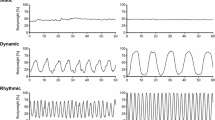Abstract
Background and aims: Unsupported standing is one of the most important functional tasks involving balance control. Unlike younger people, who have been shown to counteract imbalance preferably with an ankle strategy, older people tend to do so with a hip strategy. These strategies can be described by matching balance measures at floor and hip level, a good match representing an ankle-dominant strategy and a low one a hip-dominant strategy. The aim of this study was to show possible change in the association between force platform measurement at floor level and accelerometry at hip level in elderly inpatients standing unsupported during rehabilitation. Methods: Fortyfour elderly inpatients (mean age 82.5 yrs) after hip fracture or stroke were recruited for the study. Balance was assessed after admission and 2 weeks later on a force platform at floor level and simultaneously by a tri-axial accelerometer at hip level. Results: The correlation between the 2 measures was initially poor to fair (r=0.04 to r=0.51), but increased after 2 weeks of rehabilitation (r=0.30 to r=0.66). Conclusions: A change in the association between measures obtained at lower back level and floor level may indicate a change from a hip- to an ankle-dominant strategy, to counteract imbalance during unsupported standing.
Similar content being viewed by others
References
Guralnik JM, Simonsick EM, Ferrucci L et al. A short physical performance battery assessing lower extremity function: association with self-reported disability and prediction of mortality and nursing home admission. J Gerontol 1994; 49: M85–94.
Jarnlo GB. Functional balance tests related to falls among elderly people living in the community. Eur J Geriatr 2003; 5: 7–14.
Winter DA. Human balance and posture control during standing and walking. Gait Posture 1995; 3: 193–214.
Pajala S, Era P, Koskenvuo M, Kaprio J, Tormakangas T, Rantanen T. Force platform balance measures as predictors of indoor and outdoor falls in community-dwelling women aged 63–76 years. J Gerontol A Biol Sci Med Sci 2008; 63: 171–8.
Colobert B, Cretual A, Allard P, Delamarche P. Force-plate based computation of ankle and hip strategies from double-inverted pendulum model. Clin Biomech (Bristol, Avon.) 2006; 21: 427–34.
Allum JH, Adkin AL. Improvements in trunk sway observed for stance and gait tasks during recovery from an acute unilateral peripheral vestibular deficit. Audiol Neurootol 2003; 8: 286–302.
Chiari L, Mancini M, Zampieri C, Carlson P, Peterka RJ, Horak FB. The use of wearable inertial devices to detect postural changes in early Parkinson’s Disease. Proc. First International Conference on Ambulatory Monitoring of Physical Activity and Movement. Rotterdam, 2008, p 82.
Kamen G, Patten C, Du CD, Sison S. An accelerometry-based system for the assessment of balance and postural sway. Gerontol 1998; 44: 40–5.
Mayagoitia RE, Lotters JC, Veltink PH, Hermens H. Standing balance evaluation using a triaxial accelerometer. Gait Posture 2002; 16: 55–9.
Moe-Nilssen R. Test-retest reliability of trunk accelerometry during standing and walking. Arch Phys Med Rehabil 1998; 79: 1377–85.
Helbostad JL, Askim T, Moe-Nilssen R. Short-term repeatability of body sway during quiet standing in people with hemiparesis and in frail older adults. Arch Phys Med Rehabil 2004; 85: 993–9.
O’Sullivan M, Blake C, Cunningham C, Boyle G, Finucane C. Correlation of accelerometry with clinical balance tests in older fallers and non-fallers. Age Ageing 2009; 38: 308–13.
Winter DA. A.B.C. (Anatomy, biomechanics, control) of balance during standing and walking. Ontario: Waterloo Biomechanics, 1995.
Caron O, Faure B, Breniere Y. Estimating the centre of gravity of the body on the basis of the centre of pressure in standing posture. J Biomech 1997; 30: 1169–71.
Shimba T. An estimation of center of gravity from force platform data. J Biomech 1984; 17: 53–60.
Mancini M, Rocci L, Capello A, Chiari L. Comparison of wearable inertial devices and force plates for stance posture measurements. Gait Posture 2008; 28(S1): S31.
Zatsiorsky VM, King DL. An algorithm for determining gravity line location from posturographic recordings. J Biomech 1998; 31: 161–4.
Manchester D, Woollacott M, Zederbauer-Hylton N, Marin O. Visual, vestibular and somatosensory contributions to balance control in the older adult. J Gerontol 1989; 44: M118–127.
Katzman R, Brown T, Fuld P, Peck A, Schechter R, Schimmel H. Validation of a short Orientation-Memory-Concentration Test of cognitive impairment. Am J Psychiatry 1983; 140: 734–9.
Era P, Sainio P, Koskinen S, Haavisto P, Vaara M, Aromaa A. Postural balance in a random sample of 7,979 subjects aged 30 years and over. Gerontology 2006; 52: 204–13.
Moe-Nilssen R, Helbostad JL. Trunk accelerometry as a measure of balance control during quiet standing. Gait Posture 2002; 16: 60–8.
Immich H. Medizinische Statistik. Stuttgart - New York: Schattauer, 1974.
Fuschillo VL, Bagala F, Chiari L, Cappello A. Single axis accelerometer COM, COP and ankle joint moment prediction in an inverted pendulum balance model. In: Cappello A, D’Alessio T, Knaflitz M et al, Eds. Atti del Congresso Nazionale di Bioingegneria 2010. Bologna: Patron, 2010: pp 221–2.
Author information
Authors and Affiliations
Corresponding author
Rights and permissions
About this article
Cite this article
Lindemann, U., Moe-Nilssen, R., Nicolai, S.E. et al. Assessment of balance in unsupported standing with elderly inpatients by force plate and accelerometers. Aging Clin Exp Res 24, 37–41 (2012). https://doi.org/10.1007/BF03325352
Received:
Accepted:
Published:
Issue Date:
DOI: https://doi.org/10.1007/BF03325352




